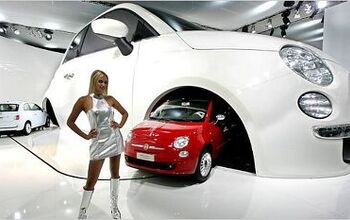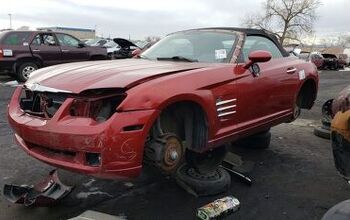Chrysler Zombie Watch 3: Zombie Strippers!
Proponents of Chrysler’s current reinvention often refer to the exercise as a “surgical” bankruptcy. OK, who’s the surgeon? As far as I can tell, the people in charge of deciding how to cut-up Chrysler are Chrysler. “Physician heal thyself” is a nice sentiment, but it doesn’t normally involve a scalpel. Second, speed. When a patient is bleeding to death, time is of the essence. Chrysler is hemorrhaging red ink. It’s one thing to stop the bleeding (as Uncle Sam adds multi-billion dollar cash infusions). It’s another to attempt to cure the patient with a knife. And after the health care recipient leaves the theater, well, who expects an amputee to run a marathon? In other words, the operation may be a success, but the patient will still die.
The counterpoint: synergy. Or, to call it by its rightful name, “wishful thinking.” In the course of human history there must have been two huge companies working in a hideously complicated manufacturing enterprise who were able to integrate with each other and prove that the whole is greater than the sum of the parts. A partnership that delivered cost reductions though combined “back office” functions. More efficient and creative product development. Better sales and marketing. Streamlined management. A more productive workforce. It’s just that I can’t think of any.
[Renault – Nissan? The fact that this partnership works at all—and the jury’s still out—is down to the fact that the two companies tend to stay out of their each other’s way.]
It’s ironic that the American carmaker that forged a company-killing merger with a German automobile manufacturer almost eleven years ago to the day now wants US taxpayers, suppliers, creditors, workers, the media, etc. to accept the idea that Chrysler’s future is best served by merging with an Italian automobile manufacturer. To borrow an adjective from the non-TARPies court filing, that’s “incomprehensible.” Unless you try really hard to believe that someone isn’t stripping assets from someone else. To wit: The New York Times.
Fiat and Chrysler have much to offer each other. Chrysler desperately needs Fiat’s small cars and fuel-efficient engines to balance an aging lineup of S.U.V.’s.
For Fiat, Chrysler offers an instant dealership network for its return to the United States. They can also benefit from savings on the $46 billion worth of parts and materials they would buy as a combined entity.
The whole “ChryCo needs small cars” meme flies in the face of any realistic appraisal of commercial reality. Stateside, small cars a small part of a shrinking market; Chrysler needs small cars like a man dying of thirst desperately needs a shot glass of low-alcohol beer. Chrysler needs a mainstream model that generates enough profits to sustain their credibility the next time they call on the public purse. I mean, to repay their “loans.” Something like the Chrysler 300. Only a lot better.
The merger’s small car justification violates a pseudo-military maxim: go where they ain’t. Trying to sell small cars in a mature marketplace against highly-developed, well-entrenched competition is a Sisyphusian endeavor. GM’s failure to recapture its automotive mojo in its North American and European home markets—even while it succeeded outside of North America and Europe—proves the wisdom of the advice.
Besides, Chrysler already has small cars. Yes, they’re crap. But fixing ChryCo’s crap cars would be a lot less expensive and time consuming than hitting reset. Again. And that’s without adding Fiat’s cultural dissonance to the mix.
Clearly, there’s a political subtext to this supposed “desperation.” ChyrCo’s political overlords and their camp (not in the Batman TV series sense of the word) followers have a hard-on for American-built small cars/hybrids. To use an Obama-ism, they believe it’s “the right thing to do.” But even The Gray Lady understands that it’s probably not the most profitable thing to do; hence the SUV “balancing” remark.
As for the joint savings on parts, somebody somewhere’s smoking one. Three years after assuming control of Ford, CEO Alan Mulally still hasn’t fully realized his plan for parts worldwide parts commonality. Similarly, GM’s “world car” program has been a spectacular failure, delivering unto the world a seemingly endless stream of badge-engineered failures (e.g., Cadillac BLS), non-starters (e.g.,Pontiac G8) and nichemobiles (e.g., Chevrolet Camaro).
Just for S&G, figure Fiatsler will save ten percent on its $46 billion parts and materials tab. Split it two ways. That’s a $2.3 billion cost reduction. Which is not even half of Chrysler’s current cash burn. Or the United States government’s outstanding “loans” to the Auburn Hills zombie. This theoretical saving might pay for the bureaucracy needed to organize the two automakers’ parts integration. It might not. if history is any guide, any such attempt would end up costing money and delaying production.
So where’s the beef? Nowhere. The Chrysler – Fiat deal is one of those veggie burgers that only looks good—and then only to vegetarians. It sounds crazy, and it just won’t work.
More by Robert Farago
Latest Car Reviews
Read moreLatest Product Reviews
Read moreRecent Comments
- SCE to AUX With these items under the pros:[list][*]It's quick, though it seems to take the powertrain a second to get sorted when you go from cruising to tromping on it.[/*][*]The powertrain transitions are mostly smooth, though occasionally harsh.[/*][/list]I'd much rather go electric or pure ICE I hate herky-jerky hybrid drivetrains.The list of cons is pretty damning for a new vehicle. Who is buying these things?
- Jrhurren Nissan is in a sad state of affairs. Even the Z mentioned, nice though it is, will get passed over 3 times by better vehicles in the category. And that’s pretty much the story of Nissan right now. Zero of their vehicles are competitive in the segment. The only people I know who drive them are company cars that were “take it or leave it”.
- Jrhurren I rented a RAV for a 12 day vacation with lots of driving. I walked away from the experience pretty unimpressed. Count me in with Team Honda. Never had a bad one yet
- ToolGuy I don't deserve a vehicle like this.
- SCE to AUX I see a new Murano to replace the low-volume Murano, and a new trim level for the Rogue. Yawn.


































Comments
Join the conversation
NBK-Boston : The question then becomes, what is the best way to help the intended beneficiaries?" I'm glad you can see the forest for the trees...it has been obvious for a while that this is the administration's intention and seen as a social transistion cost. To your question, I argue that the way this is being handled is EXACTLY the wrong way to go about it if for no other reason than the culture of the automotive industry workforce. While my own company and potentially job security would be affected by a liquidated Chrysler, creating a Chrysler-hand-puppet that looks like a company but makes no money only serves to reinforce the mentality for those workers to continue to believe that they will somehow continue to be 'saved' and do not have to find some other vocation, seek more education, or change their lifestyle. The Chrysler employees who did figure out that the transistion yo reference is inevitable took buyouts and are already headed down that path. The $6B-$8B of taxpayer money would be better spent helping to educate the unemployed on their situation and options and help them to figure out 'what's next?'. In addition, that money could be used to create a business environment that limits market barriers to entry and promotes entrprenuership. That's how an economy grows. We have all forgotten that "Necessity is the mother of invention". When in history has every country and company been all focused on the next big thing (green energy) and had that actually be it? Some guy in his garage will find the next big thing just like Henry Ford, Steve Jobs, and Bill Gates - green energy will struggle along for the next 10-20 years with little to no profit viability and intense competition. As a society we will still bear these costs at some point in the future because as close of a call as this is to total liquidation, many, many workers are still not using this as an opportunity to re-evaluate their life's plan or follow a passion that creates a new industry. We are now paying at least double, if not triple for the social costs of transistion instead of paying once to promote innovation and entreprenuership.